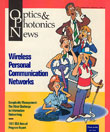
February 1992 Issue
Feature Articles
Complexity Management—The Other Challenge To Information Networking
The vision of Information Networking is access to information at any time, from any place, in any volume, and in any form. This vision calls for a global network of distributed, interworking, high-speed communications and computing capabilities. Fiber optic technology addresses one part of the Information Networking challenge—the need for huge bandwidths. But another major challenge is to develop the system and software architectures needed to manage the enormous complexity of a global information network. Progress in this area has been slower than in fiber optic technology, and it has been far slower than progress in computer processor speeds. Why is this so? In a word, the problem is complexity. This paper describes the complexity management challenge in general terms and one of the efforts underway to meet it. It also describes the information marketplace that awaits the emergence of a solution.
by David LeeperRevtex From Aps, Compuscripts With LaTeX
The American Physical Society (APS) has a macro package for use with LATEX called REVTEX. This column will explain how to obtain a complete APS REVTEX toolbox by mail, how to get the REVTEX macro files through INTERNET or BITNET, and why this approach to the preparation of technical manuscripts is a good idea.
by K. C. HarveyFrom Draft To Implementation: More Explanation Needed
Early in November, the group working on the new international optical drawing standard, ISO 10110, met in Tokyo to make the final technical changes in the document. The 13 parts of the draft standard now go to the editing committee to make sure the language is correct; then it will be published by ISO in Geneva as a Draft International Standard (DIS). When the DIS is published, about a year from now, it will be circulated internationally for six months prior to acceptance. From every indication, the vote will surely be to accept.
by Robert E. ParksLiquid Crystals Revisited
As I described in the April Light Touch column (page 58), liquid crystal materials are beginning to be used in an ever-increasing number of applications. I started with the properties of liquid crystals in general, and then quickly discussed the most common liquid crystal application—twisted nematic displays. These displays are used in many applications, ranging from clocks and watches to portable laptop computers. This column describes a different kind of liquid crystal—the kind used to make unbreakable fever thermometers.
by Steven E. ShieldsWireless Personal Communication Networks
To optics and photonics experts, the status of wireless communications will seem strange. There is a shortage of technology to satisfy a substantial public demand. Photonic communication, in common with other information services, progresses in an orderly fashion from science to technology to standards to products to services. Then there is a search for applications, which eventually emerge. And finally there are revenues and rewards to the virtuous. I recall a phone call from the AT&T press office, while I was at Bell Labs. The caller wanted to explain to a non-technical audience the significance of multi-gigabit transmission. I calculated that you could send all of Shakespeare, the Encyclopedia Britannica, and the Bible in a few milliseconds. The caller thanked me for the impressive illustration. Neither of us reflected much on whether anyone really wants to do that.
by David J. Goodman
![Infinity Mirrored Room– Brilliance of the Souls 2014 by artist Yayoi Kusama. [© YAYOI KUSAMA]](https://opnmedia.blob.core.windows.net/$web/opn/media/images/articles/2024/0724/departments/202407-cover-web.jpg?ext=.jpg)
![An experimental scheme demonstrated by researchers at Princeton and Yale universities, USA, can convert physical noise into errors that can be corrected more easily. [F. Wojciechowski, Princeton University]](https://opnmedia.blob.core.windows.net/$web/opn/media/images/articles/2024/0624/departments/202406-cover-web.jpg?ext=.jpg)
